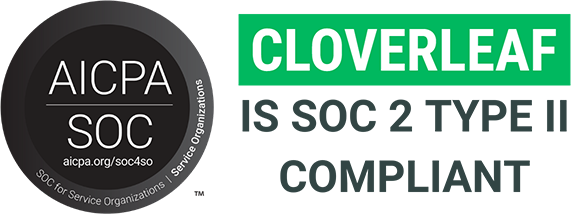In this new era, we need a more scalable and “sticky” way to elevate collaboration across our organizations. It’s imperative. Collaboration is already making or breaking projects and organizations, and with the increasing pace of work, the need for effective collaboration is only growing. We must change our tactics to achieve consistently high-quality collaboration, or our personal and collective success—and wellbeing—will suffer.
Organizations face numerous challenges in this area. By and large, they don’t define, measure, or invest in collaboration effectively. While the term is often used, real investment and measurement reveal a wide variety of gaps. Collaboration, cross-functional teamwork, and related skills are rarely trained for or measured. When training does occur, it’s usually focused on individuals, typically leaders, who are then expected to apply these skills in teams that lack similar training. This siloed approach, if it exists at all, often falls short.
Investing in the quality of collaboration is often relegated to the category of “soft skills,” implying it’s less valuable. This perception persists because the industry hasn’t cracked the code on measuring collaboration effectively and proving its connection to profits. However, focusing on human skills like communication, empathy, and teamwork can transform the way organizations operate. By embedding these skills into daily practices, organizations can strengthen trust, innovation, and agility, ultimately turning human skills into a competitive advantage.
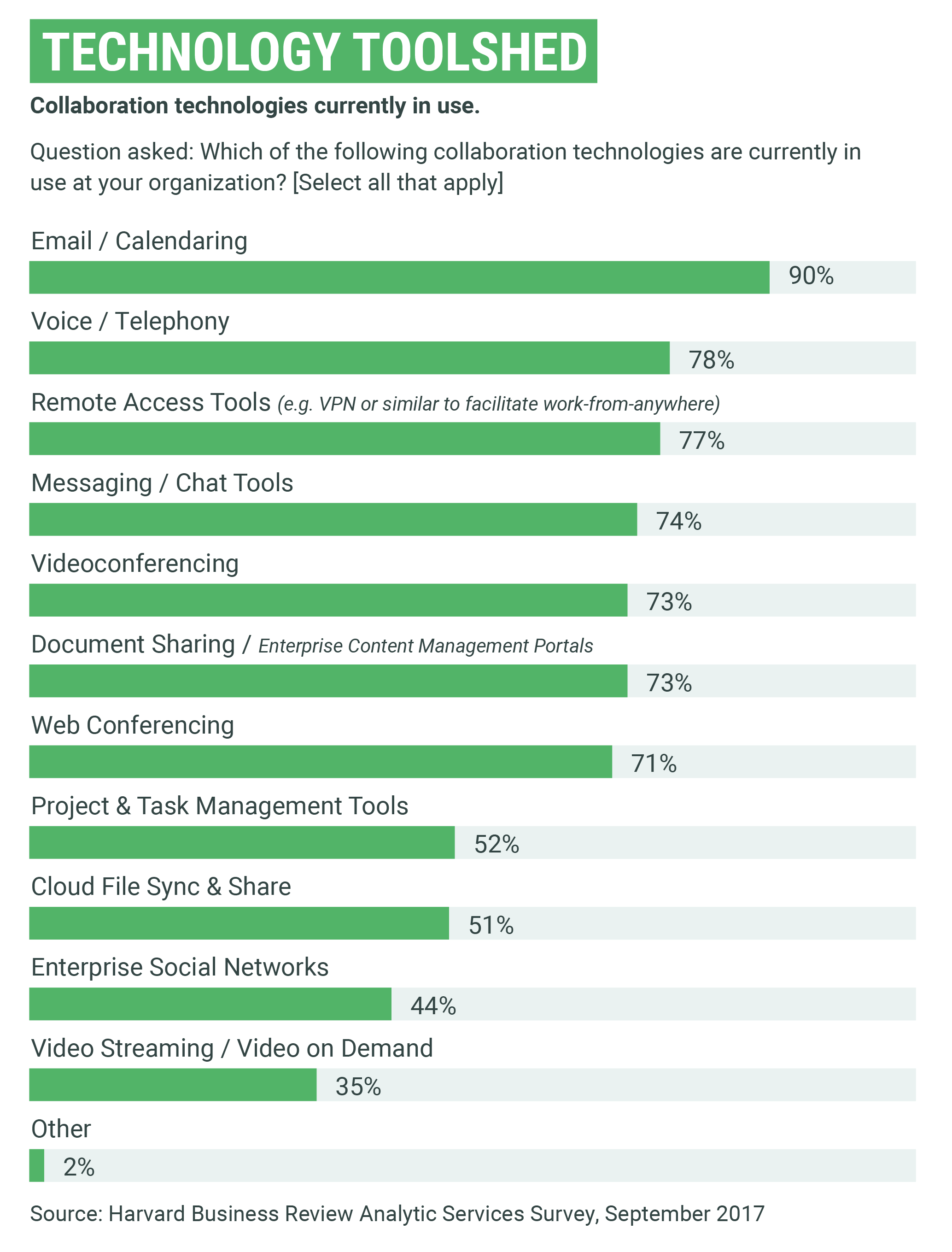
The Limitations of Traditional "Collaboration Tools"
In the broader technology market, many products are labeled as “collaboration tools.” However, these tools are mostly just communication or productivity tools. Few, if any, of the software tools currently classified as collaboration actually focus on the human (behavioral) element of collaboration.
Simply providing another channel to communicate doesn’t necessarily improve collaboration. In fact, it can often be a barrier by introducing confusion about where and how to communicate with each other. More channels can be more confusing if there isn’t a shared understanding of which channels to use and when. This often leaves people questioning where to expect a response from teammates. Email, Slack, or text? No one knows.
This Harvard Business Review survey found that while organizations use various tools to share words and files, these tools often fail to enhance true collaborative efforts. The survey revealed that while communication tools facilitate message exchange, they do not necessarily improve the effectiveness of these messages to create shared understanding and meaningful collaboration. We have too many ways to transfer messages and not enough support to build true relationships and quality communication.
We need new tools and approaches that address the work humans do to navigate our differences and achieve outcomes that build true value for the organizations we serve.
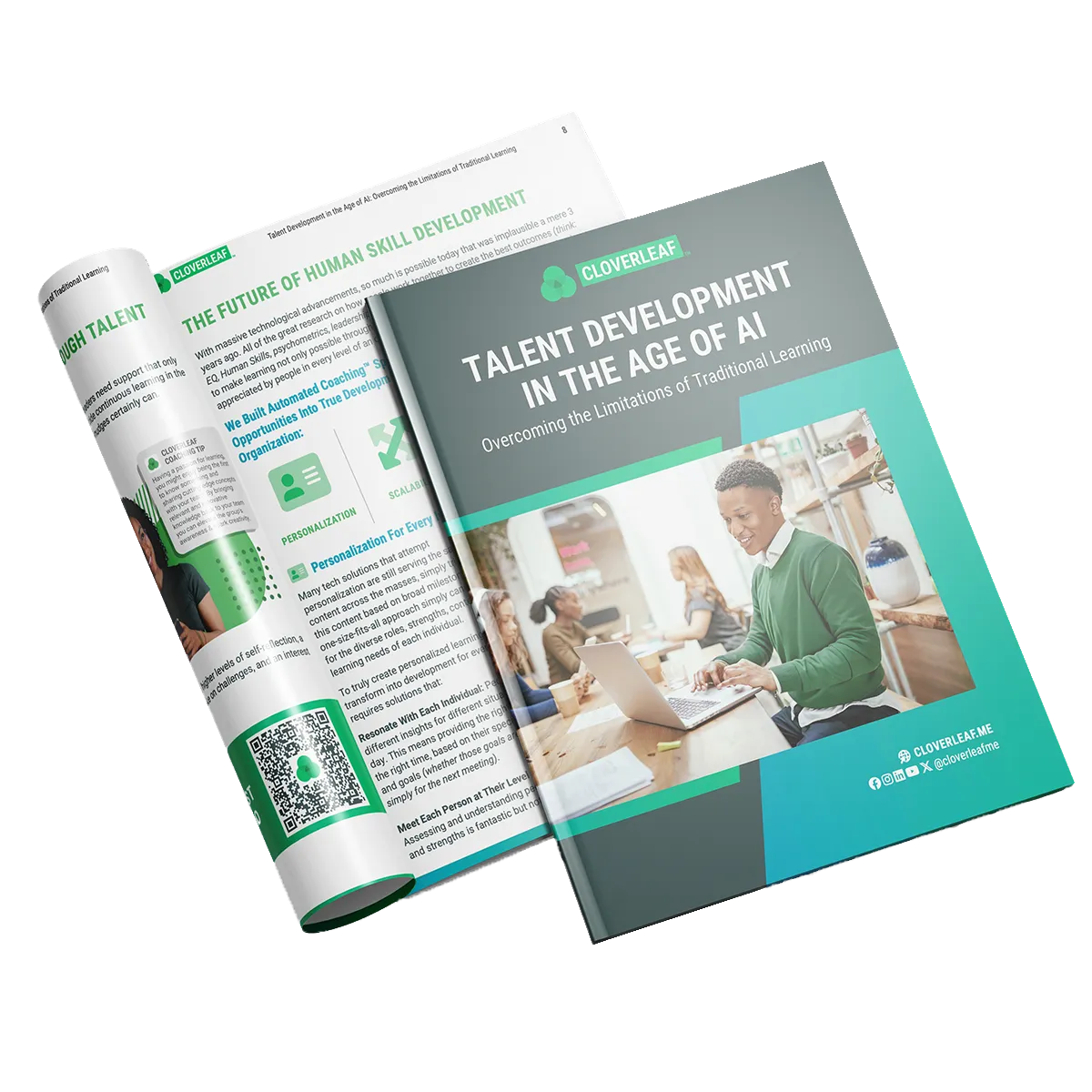
HUMAN SKILL PROGRAMS ARE HITTING LIMITATIONS...
5 THINGS THIS FREE RESOURCE WILL TEACH YOU
- Close the widening gap between learning and on-the-job application
- Overcome the tension of pausing productivity for development opportunities
- Integrate learning so it is actually in the flow of work
- The evolution of human skill development
- What Automated Coaching™ is and how it works.

Growing Collaboration Beyond Communication Tools
Current collaboration tools often fall short because they fail to address the core human elements of collaboration. Here are some specific issues:
- Overwhelming Channels: Multiple communication platforms can lead to confusion about where to communicate.
- Lack of Focus on Relationships: Effective collaboration requires tools that foster understanding and relationships, not just message exchanges.
- Missing the Behavioral Aspect: True collaboration involves navigating human behaviors and differences, which current tools do not adequately support.
The Need for Human-Centered Collaboration Tools
To truly improve collaboration, we need tools that:
1. Facilitate Understanding: Tools should help team members understand each other’s strengths, communication styles, and working preferences right in the flow of work. (Josh Bersin).
2. Build Relationships: Effective collaboration tools should focus on relationship-building and trust. (mckinsey.com)
3. Support Behavioral Changes: Tools should provide insights and nudges that help teams navigate differences and improve their collaborative efforts. Continuous learning and development platforms that offer real-time coaching and feedback can drive sustained behavioral change to improve collaboration.
Shifting the focus from mere communication to understanding and relationship-building, organizations can unlock the true potential of collaboration.
The Misnomer Of “Soft Skills“
Unfortunately, what we’re talking about here is often lumped into a broader category in the organizational context referred to as “soft skills.” This is a really annoying moniker on many levels for those of us who have dedicated our lives to improving people and organizational effectiveness. The word “soft” would seem to imply that it’s less necessary or less relevant than hard skills like software development or financial forecasting. This is also why many in talent management circles have started referring to these soft skills as “human skills”—an even more appropriate moniker in an era of artificial intelligence.
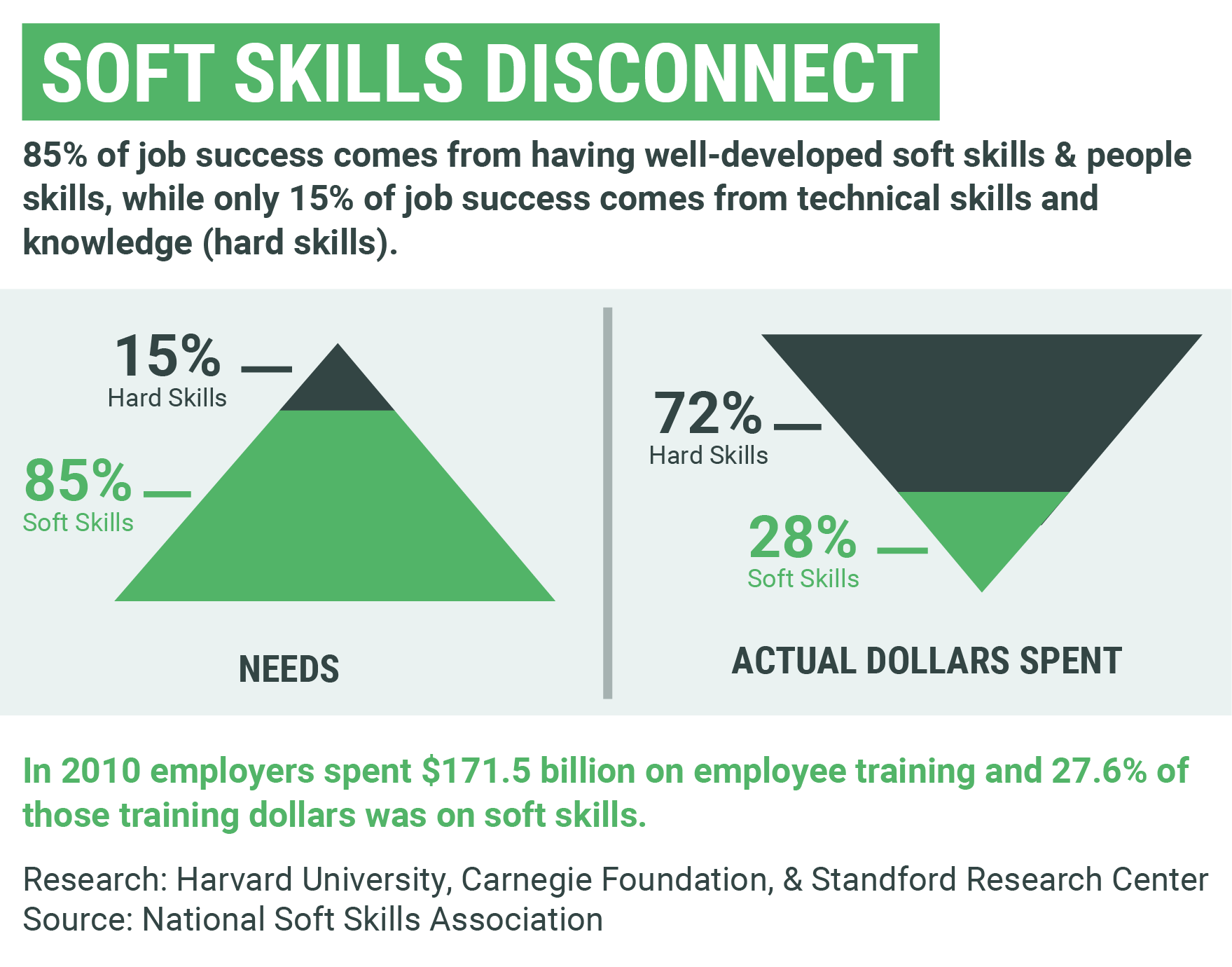
The Value of Human Skills
CFOs often like to gloss over these investments in soft skill training as frivolous and the most expendable when budget cuts are necessary. This disconnect is illustrated clearly when we examine where we are investing our talent development dollars versus what the organization and its leaders identify as the most critical skills for business success.
Despite the pervasive influence of Artificial Intelligence (AI) tools, human skills are the least likely to be displaced or replaced by AI. These skills offer exponential returns on investment compared to the incremental returns of most hard skills. For instance, learning how to use Excel better or adopting a new sales technique might improve efficiency marginally. However, understanding your teammates’ unique strengths can help avoid unnecessary conflicts and navigate differences toward significantly higher performance.
The Return on Investment (ROI) of Human Skills:
- Conflict Avoidance and Performance: A better understanding of human skills can help teams avoid conflicts and work more harmoniously, leading to higher productivity and better results.
- Market Relevance: Insights into human skills can guide the development of products and services that better meet customer needs, enhancing market success.
- Enhanced Customer Interactions: Skills in empathy, communication, and problem-solving improve customer support and sales effectiveness.
3 Challenges of Measuring Human Skills Impact
The disconnect between the investment in development dollars and the types of skills that have an outsized impact on performance boils down to measurement issues.
Challenges in Measuring Collaboration Health:
1. Lack of Standardization: There is no standardized way to measure soft skills across different organizations, making it difficult to benchmark or track progress uniformly.
2. Isolation of Impact: It is challenging to isolate the specific impact of a human skills intervention from other variables that influence performance.
3. Linkage to Financial Success: Drawing a direct and clear line between improvements in human skills and financial metrics like revenue growth or churn rates is complex and often indirect.
Let’s look at each of these in more detail.
1. The Need for Standardized Measurement in Human Skills
When discussing gross margin, businesses can quickly provide a percentage that reflects a standardized calculation. Unfortunately, such standardization for human skills and collaboration metrics is lacking. While we can measure turnover and engagement, how do we quantify collaboration, psychological safety, trust, or leadership?
Measuring Human Capital: SEC’s Steps
The SEC has recognized this gap. On August 26, 2020, they mandated that companies disclose their human capital resources in quarterly and annual reports. This includes any human capital measures or objectives that are key to managing the business.
Trends in Human Capital Reporting
Gibson Dunn’s study on the S&P 500’s compliance reveals significant variability in disclosures:
- Disclosures ranged from 109 to 1,995 words, averaging 960 words.
- 25% of companies avoided quantitative metrics, and 10% included only headcount numbers.
- Significant increases in disclosures on talent attraction, retention, compensation, diversity, health, and pay equity were noted.
There is no standardization in human capital metrics across companies. This variability underscores a lack of understanding of the value human skills bring to organizational success.
The SEC’s requirements are a start, pushing us towards more transparency and investment in people. International standards like ISO 30414 offer some guidance but remain voluntary.
By moving towards standardized measurements for human skills, organizations can better align investments with the factors that drive success, ultimately gaining more actionable insights into their most valuable assets: their people.
2. Isolating the Impact of an Intervention
Organizations invest $350 billion annually in learning and development (L&D) across various interventions, including online courses, in-person training, assessments, coaching, and more. How do we measure the impact of these development opportunities?
Consider an employee named Raj, who improved his performance after participating in multiple programs and moving to a new team with a new manager. How can we determine whether his performance boost was due to the training, the new team, or the new manager?
Current Measurement Practices: Many L&D leaders rely on surveys to gauge effectiveness:
- Surveys ask if the training was helpful.
- Surveys ask if managers are effective.
- Surveys ask if employees feel they have access to needed development programs.
Limitations of Surveys
- Sentiment vs. Metrics: Surveys measure feelings, not direct ties to business metrics like revenue or turnover.
- Survey Fatigue: People are tired of surveys, leading to low completion rates.
- Time-Based Approach: Pre- and post-intervention surveys measure short-term changes, but it’s hard to ensure lasting impact. Studies show that most training knowledge is forgotten within a week.
How can you know if someone’s behavior change will stick? Study after study shows that people forget most of what they learn in training courses within a week. How can development professionals truly measure if their programs create lasting change for months and years?
3. Linking Investments to Financial Success
How do investments in people translate into financial success? While studies show that companies investing in salary, benefits, or L&D are more productive, proving a direct link is tough.
How do investments in people translate into financial success? While studies show that companies investing in salary, benefits, or L&D are more productive, proving a direct link is tough. Demonstrating the ROI of collaboration is even harder. Before Organizational Network Analysis (ONA), quantifying collaborative activity was nearly impossible. Now, tools like Microsoft 365, Google Suite, Slack, Salesforce, and GitHub generate vast data showing who is connecting and communicating within teams.
ONA can identify key connectors, highlight areas of isolation, and pinpoint communication breakdowns. However, it still doesn’t easily link these activities to financial metrics. It measures communication quantity, not quality. High volumes might indicate miscommunication, gossip, productive brainstorming, disengagement, or efficient alignment.
Organizational Development leaders face challenges in proving the impact of leadership programs on emotional intelligence and psychological safety, which are crucial for reducing turnover, increasing engagement, and accelerating innovation. Surveys can gauge sentiment but often fail to show direct ties to financial outcomes. This gap makes it hard to secure budget approval for development initiatives without leaders’ belief in the value of investing in people.
Unlocking the Potential of Quality Collaboration
Valuable collaboration is under-invested because we think of it in terms of quantity or channels rather than quality. We lack a common language and numerical proof linking it directly to profit. However, effective collaboration leads to profit and enhances the quality of life for employees and customers.
The convergence of macro-trends, SEC requirements for human capital considerations, and technological advancements present an opportunity to empower effective human skill interventions and measure high-quality collaboration’s impact.
The explosion of data and new techniques promises a future where we better understand how collaboration impacts productivity, innovation, and value creation. For now, approaches remain inconsistent across companies and teams.
At Cloverleaf, we have a front-row seat with millions of people in tens of thousands of teams across hundreds of organizations both large and small, for what is working and what is ineffective in collaboration. We built Automated Coaching around proven concepts that work, grounded in decades of research and validated by real-world applications, resulting in quality collaboration, value creation, and life-changing outcomes. To see Cloverleaf in action or schedule a demo, click here.
Have you ever wondered about the buzz around emotional intelligence (EQ)? This concept, explored for decades, truly gained traction with Daniel Goleman’s groundbreaking book. Imagine this: while the content of our work (our IQ) deals with the ‘what,’ EQ is all about the ‘how’ — managing our emotions, understanding others, and nurturing relationships. It’s like knowing the notes but mastering the music in leadership.
Emotional intelligence (EQ) is not just a buzzword; it’s a pivotal skill in leadership, akin to a harmonious dance between different parts of our brain. Effective management intertwines the analytic network (AN) and the empathic network (EN) in our brains. As this Harvard Business Review article highlights, leaders who can balance these neural networks drive better business outcomes and cultivate an environment rich in empathy and understanding. Your ability to connect and build rapport, crucial in today’s collaborative work culture, hinges on self-awareness and empathy.
EQ is the secret ingredient for personal growth and organizational triumph. It’s not just about being smart; it’s about being wisely connected to those around you. In a workplace where employee engagement and job satisfaction can so significantly be impacted by the quality of the leader, sharpening emotionally intelligent leadership is necessary for individual and organizational success.

What Is Emotional Intelligence?
Emotional intelligence, or EQ, is your skill in understanding and managing your own emotions, as well as recognizing and responding to the emotions of others. It’s a blend of five essential skills:
- Self-awareness (recognizing your emotions)
- Self-regulation (controlling emotions)
- Motivation (using emotions to drive yourself forward)
- Empathy (understanding others’ emotions)
- Social skills (using emotional understanding in interactions)
It’s more than just feeling emotions; it’s using them to enhance communication and relationships.
Unpacking the 5 Components of Emotional Intelligence
Embracing emotional intelligence in leadership is like tuning a musical instrument – it’s about finding harmony in your strengths and addressing the areas that need a little more attention. EQ unfolds in five key components, each uniquely influencing effective leadership. Let’s dive into these components, and I’ll offer some coaching questions to help you reflect on your strengths and areas for growth.
1. Self-Awareness: Reflecting on Your Inner World
This is the cornerstone of EQ. It’s about understanding your emotions and the ‘why’ behind them. It’s like being the detective of your mind, unraveling the mysteries of your reactions and feelings.
Reflective Questions:
- Do you recognize how your actions echo in your workplace?
- What are your go-to practices for maintaining self-awareness?
- How do you respond to critical feedback – with openness or defensiveness?
2. Self-Regulation: Navigating Emotional Currents
Picture this as the art of emotional balance. It’s about managing your emotions, particularly the challenging ones, and responding to workplace situations with poise and thoughtfulness.
Reflective Questions:
- Can you identify your emotional triggers in the workplace?
- After a tough conversation, do people feel respected and heard?
- How do you maintain your equilibrium during emotional turbulence at work?
Self-Regulation in Action: Let’s take a real-world scenario. Imagine you’re in a heated team meeting. Someone challenges your idea, and you feel conflict rising. A leader skilled in self-management might take a moment to breathe, recognize their emotional response, and choose to respond calmly and constructively, turning a potential conflict into a productive discussion. This approach can diffuse tension and model emotional maturity for the team.
By exploring and enhancing these components of EQ, you’re not just growing as a leader but enriching the entire team dynamic. You’re fostering an environment where emotional intelligence is the norm, not the exception. So, as you ponder these questions, think about how your answers resonate with your leadership style and how they impact those around you.
3. Motivation: Sparking Your Inner Drive
In the realm of EQ, motivation isn’t just about ticking boxes or hitting targets; it’s an internal journey. It’s about igniting your intrinsic drive to grow and stay true to your goals, coupled with a dose of optimism and resilience. Think of it as the inner compass guiding your leadership journey.
Coaching Questions for Motivation:
- What goal-setting frameworks energize you?
- Who in your circle is your ‘motivation mentor’ keeping you accountable?
- Are you open to discovering silver linings in challenging situations?
- How do you cultivate resilience to rebound from setbacks?
Imagine a leader facing a project delay. Instead of spiraling into frustration, leaders with emotional intelligence tap into their motivation, see the delay as an opportunity for refinement and encourage the team to view challenges as growth moments.
4. Empathy: Empathy: Connecting with Diverse Perspectives
Empathy in leadership transcends mere sympathy. It’s about stepping into another’s shoes and understanding the perspective and emotions of others, even when they diverge from your own. This is especially vital in appreciating the diversity of thoughts and experiences in the workplace.
Coaching Questions to Practice Empathy:
- Do you embrace or resist perspectives different from your own?
- How much effort do you put into building trust and understanding within your team?
- Reflect on a time when someone’s empathy made a difference to you. What impact did it have?
- What practices help you connect with others’ experiences and viewpoints?
- Consider a leader handling an argument. By practicing empathy, leaders can successfully use conflict resolution to strengthen the team, showing that understanding diverse viewpoints is not just about solving problems but building a more inclusive and harmonious culture.
5. Social Skills: The Art of Engaging Communication
Social skills in leadership go beyond mere talking; it’s about mastering the art of listening and empathetically connecting with others. Great social awareness means you can convey your thoughts confidently and respectfully, handling conflicts gracefully, even in the trickiest situations.
Reflective Questions for Enhancing Social Skills:
- Where in your team interactions could your communication be more impactful?
- Do you adopt a ‘coach approach’ in conversations, prioritizing curiosity and listening over directing and explaining?
- How do your team members view your role in group dynamics?
- Are you the go-to person for advice, support, or resolution?
Soft Skills in Action: Consider a scenario with a misunderstanding in your team. An emotionally intelligent leader uses this opportunity to clarify and understand an individual’s underlying concerns. They listen actively, ask open-ended questions to uncover deeper insights, and then communicate solutions that resonate with everyone involved.
Enhancing your social skill competencies is not about changing who you are but evolving how you interact and connect. It’s about being a leader who listens, understands, and then leads – a leader who’s as adept with people as they are with projects.

HUMAN SKILL PROGRAMS ARE HITTING LIMITATIONS...
5 THINGS THIS FREE RESOURCE WILL TEACH YOU
- Close the widening gap between learning and on-the-job application
- Overcome the tension of pausing productivity for development opportunities
- Integrate learning so it is actually in the flow of work
- The evolution of human skill development
- What Automated Coaching™ is and how it works.

The Impact of EQ in Leadership Dynamics
Reflecting on the EQ-related questions we’ve discussed, it’s clear how they can streamline our interactions at work. Often, we fall into the trap of making assumptions about others’ behavior, shaping our responses based on these perceptions. Emotional intelligence flips this script. It empowers us to be leaders, prioritizing understanding and empathy and putting learning before action.
True leadership begins with self-leadership. When deeply connecting with our truths, we’re better equipped to lead authentically, transcending the confines of titles and roles.
Great leaders stand out in their ability to make informed decisions and guide their teams effectively. They are adept at tuning into both their own emotions and their team members. This deep understanding enables them to master team dynamics, smoothly navigate conflicts, and maintain a strong team identity focused on collaborative success. Here’s a look at four key benefits when leaders operate with high emotional intelligence:
4 Key Benefits of High EQ in Leadership
1. Elevated Team Performance and Collaboration: Successful leaders with high EQ excel in ‘reading the room’ and understanding themselves, which is crucial for steering teams toward meaningful collaboration. This ability to mitigate conflict and foster productive dialogue keeps teams laser-focused on objectives, steering clear of the pitfalls of unresolved dynamics.
2. Enhanced Decision-Making and Problem-Solving: Emotionally intelligent leaders navigate the emotional landscape of their team with finesse, building strong connections. This fosters a collaborative environment for decision-making and problem-solving. By leveraging individual strengths, they keep the team unified and centered on the task at hand, avoiding interpersonal friction.
3. Strengthened Interpersonal Relationships: A leader with high emotional intelligence builds strong one-on-one connections and amplifies the entire team’s relational dynamics. Their charisma and leadership skills are key in coaching team members and cultivating positive and productive team interactions.
4. Resilience During Challenges and Stress: A high EQ leader is calm in storms and high-pressure situations. They navigate stressful deadlines and challenging projects with ease and assurance, fostering an environment of trust and collaboration. This resilience is crucial in guiding teams through turbulent times while maintaining focus and morale.

EQ in Action: Beyond the Boardroom
Indra Nooyi’s tenure as PepsiCo’s CEO profoundly exemplifies emotionally intelligent leadership. Her unique gesture of writing personal letters to the parents of her executive team members showcased a deep emotional connection. This simple yet powerful act demonstrated an appreciation for the human stories behind each employee, fostering a high-trust work environment.
However, the influence of EQ extends beyond nurturing a positive workplace. Research substantiates that companies with a culture of high empathy often see tangible benefits in their performance and revenues. This underscores that EQ isn’t just about feel-good factors; it directly contributes to the bottom line, proving that empathy and emotional understanding are valuable assets in any successful business strategy.
Cultivating EQ: A Journey of Continuous Growth
Developing emotional intelligence isn’t a one-off achievement; it’s an ongoing process of practice and refinement. Think of it like gardening – nurturing growth through consistent care and attention. Here are four strategies to cultivate your EQ:
1. Self-Awareness Exercises:
Incorporate consistent self-awareness practices like journaling or reflection. This could be a daily routine or several times a week. The key is repetition, which steadily boosts self-awareness. Cloverleaf’s reflections feature offers an excellent tool for teams to engage in this practice, fostering a mindful start to the workday.
2. Feedback Loops and Seeking Input:
Actively seek feedback during formal reviews and everyday interactions. Regularly asking for input and observing response patterns provides valuable insights into how others perceive you and your actions. This practice is crucial in understanding and improving your impact on those around you.
3. Active Listening Practices:
It’s more than just not talking; it’s about truly understanding before responding. Resist the urge to jump into explanations and instead cultivate curiosity about the person or situation. Practice asking questions rather than always offering solutions.
4. Continuous Learning:
Engage in varied activities like reading, participating in group discussions, attending conferences, or receiving coaching. The goal is to deepen your understanding of yourself and others continuously. Don’t just absorb information; discuss it, reflect on it, and set practical goals to apply what you’ve learned.
Developing emotional intelligence transcends academic learning; it’s an experiential and personal journey. It’s not a skill mastered overnight nor gleaned from a book. It demands time, openness, and a willingness to venture beyond your comfort zone. Remember, we’re all on this path of self-discovery and a better understanding of others. It’s a shared human journey. Commit to your goals, not just at work but in every interaction. Let each step take you closer to leveraging your best self, embracing every opportunity to grow and connect more deeply.
Explore how Cloverleaf enhances leadership through emotional intelligence. Discover our unique approach to merging EQ development with leadership growth so that you can align them with your organization’s goals. See how Cloverleaf’s tools can help you validate ROI and uplift individual and team performance. Begin your journey to leadership excellence and teamwork today with Cloverleaf.
Emotional intelligence in the workplace can greatly impact the success and productivity of a team. It involves understanding and managing your own emotions, being aware of other’s emotions, and adapting to new situations.
Traditional leadership models have primarily focused on technical skills rather than soft skills like emotional intelligence. Some leaders may not understand the impact of emotions on workplace performance and decision-making. At the same time, others may believe emotions are personal and have no place in the workplace.
Plus, developing emotional intelligence skills can be time-consuming and may not be seen as a priority for leaders focused on meeting short-term goals and targets. However, as awareness of the importance of emotional intelligence continues to grow, it is becoming increasingly clear that leaders who invest in developing their emotional intelligence and that of their teams can reap significant benefits for their organizations.
How Is Emotional Intelligence Being Used In The Workplace?
Emotional intelligence in the workplace is critical to mastering interpersonal skills, crucial for conflict management and effective communication. It involves understanding and regulating emotions to make thoughtful, objective decisions. With the ability to recognize others and their own emotions, employees can support a more collaborative and empathetic work environment. Assessment tools like MBTI and DISC can identify individual strengths and preferences, helping teammates to understand each other to drive success and well-being.
In this post, we will explore why emotional intelligence is so important in the workplace, provide examples of self-awareness, and share strategies for increasing emotional intelligence among teammates.
Why Is Emotional Intelligence In The Workplace So Valuable?
Individuals with high EQ tend to be better leaders, have stronger interpersonal skills, and are more effective in handling workplace stress and conflict.
For example, a study by TalentSmart found that 90% of top performers have high EQ. Another study by Hay Group found that leaders with high EQ have teams that are more engaged, more productive, and experience less turnover.
Research in the Journal of Organizational Behavior outlines that individuals with high emotional intelligence are better equipped to overcome one of the most significant obstacles in their work-life: employment gaps. These gaps can be involuntary, such as a termination, or voluntary, like taking time off to care for family. The higher an employee’s emotional intelligence, the more likely they are to navigate interruptions in their employment successfully.
It’s no surprise that high EQ is linked to increased job satisfaction, improved job performance, better relationships with coworkers and leaders, and employee retention.
And soft skills aren’t just great for creating a fulfilling and pleasant work environment. The link between profit and leaders with high emotional intelligence is clear. In one study, CEOs whose employees rated them high in character had an average return of 9.35% over a two-year period, nearly five times as much as companies with CEOs who had low character ratings.
Prioritizing emotional intelligence in the workplace can drive significant improvements to an organization’s bottom line. If high EQ among teammates can affect job satisfaction, performance, and employee retention, investing in EQ development within teams can be a wise business decision for leaders.
IF EQ In The Workplace Is So Important, Why Do Top-Level Leaders Resist Prioritizing It?
It’s not uncommon for leaders to push off emotional intelligence initiatives because they are familiar and comfortable with traditional measures of job performance. Things like technical skills and intelligence seem easier to quantify and measure.
A Wall Street Journal survey of 900 executives found that 92% said soft skills were equally important or more important than technical skills. But 89% of those surveyed said they have a “very or somewhat difficult time finding people with the requisite attributes.”
Additionally, they may not realize the impact of soft skills training in achieving long-term success. Further, the lack of an established or standardized method for measuring EQ could also lead to it being overlooked as a valuable metric for success.

For decades scholars have debated the relative importance of cognitive intelligence (IQ) versus emotional intelligence (EQ) to workplace performance. Research shows both are helpful. However, in the era of COVID-19, my bet is on emotional intelligence playing a much stronger role. –fastcompany.com
Remote work and other factors shaping the future workplace experience require stronger levels of communication and collaboration. As traditional workplace dynamics and routines have been disrupted, EQ becomes even more crucial in helping teammates navigate workload, well-being, conflicts, and fulfillment to create a place to thrive in their work.
We define emotional intelligence (EQ) as the power to identify, handle, and express emotions and to comprehend and empathize with the emotions of others. When it comes to the workplace, having a high EQ is crucial for building trust and managing conflict to be an effective team.
Self-awareness emerges from two places:
Internally: Understanding one’s desires, strengths, weaknesses, and impact on others.
Externally: Realizing how others interpret and experience you.
When it comes to internal and external self-awareness, it’s tempting to value one over the other. But leaders must actively work on both seeing themselves clearly and getting feedback to understand how others see them. The most highly self-aware people are actively focused on balancing the scale. – Harvard Business Review
Teams that exercise emotional intelligence do more with less drama. They are tuned into their internal emotional life, can manage those feelings, and transition that energy into positive team momentum.

HUMAN SKILL PROGRAMS ARE HITTING LIMITATIONS...
5 THINGS THIS FREE RESOURCE WILL TEACH YOU
- Close the widening gap between learning and on-the-job application
- Overcome the tension of pausing productivity for development opportunities
- Integrate learning so it is actually in the flow of work
- The evolution of human skill development
- What Automated Coaching™ is and how it works.
What Does Self-Awareness In The Workplace Look Like?
Self-awareness is crucial to emotional intelligence, starting with understanding your emotions, behaviors, and thoughts. In the workplace, having a strong sense of self-awareness can take many shapes and forms, such as:
Acknowledging when you’re feeling overwhelmed, frustrated, or angry and taking proactive measures to manage those emotions
Being mindful of how your actions and words can impact others around you
Taking a step back and reflecting on your behavior to pinpoint areas that need improvement
Seeking feedback from your coworkers and superiors to understand yourself better.
Emotional intelligence is being able to understand your own emotions and manage them. It’s also the ability to observe others’ emotions, understand a situation, and adapt to remain productive at that moment.
By taking the time to understand your emotions, behavior, and thoughts and being proactive in managing them, teams can foster a positive productive work environment.
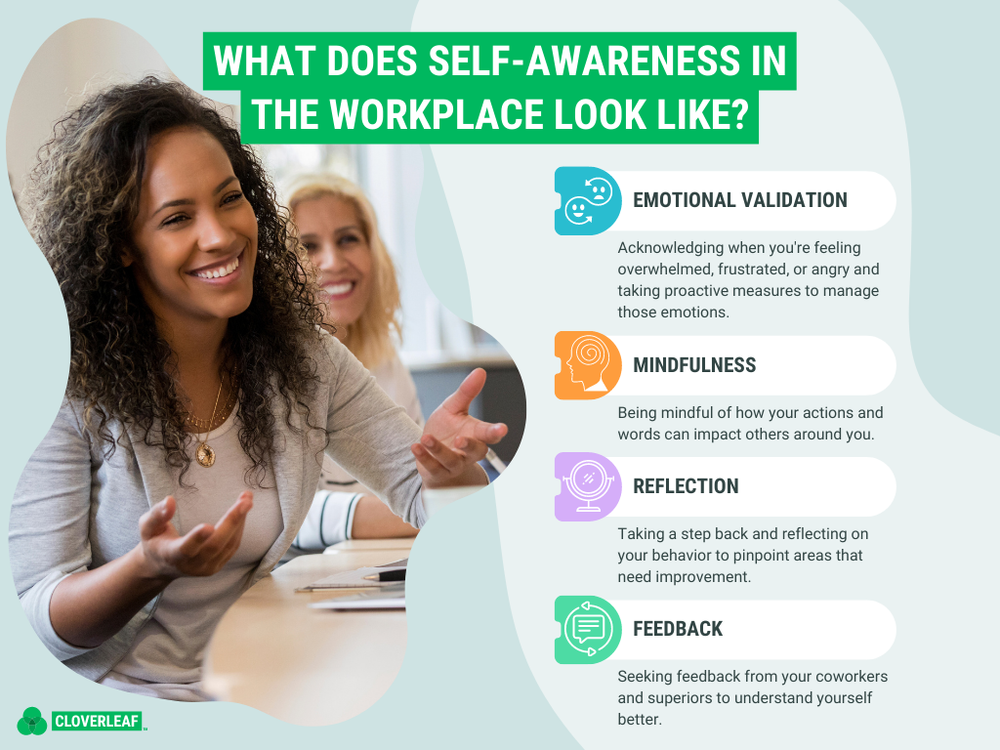
Examples Of Self-Awareness In The Workplace
Have you ever had one of those mornings where everything seems to go wrong? You arrive at work feeling overwhelmed. Every person can relate. Maybe you lost your dog, became angry in traffic, or experienced a disagreement with a family member before leaving the house. But, what if you could process those emotions and release them, allowing you to start your work day feeling recentered and in control?
Emotional intelligence can help you acknowledge and understand your emotions to prevent them from dictating your experience at work. Recentering your feelings to ensure they do not influence how you treat your teammates or drive you to make decisions because of things outside of work.
As a leader or coworker, it’s important to not only manage your own emotions but also be aware of the emotions of those around you. If you notice a colleague coming in with a negative demeanor or a bit huffy, take a moment to ask how they’re doing and if everything is okay. By simply asking questions, you can help them process their emotions and release any tension they might be feeling.
8 Questions To Help Teammates Process Their Emotions And Refocus On Work
How are you feeling right now?
Is there anything that you need to vent about or share?
Can you walk me through what has been bothering you?
What steps can we take to resolve the situation?
How can I support you at this moment?
Is there any specific task or goal you need help with?
Can you tell me more about your experience and how it has impacted you?
How do you see yourself moving forward from this situation?
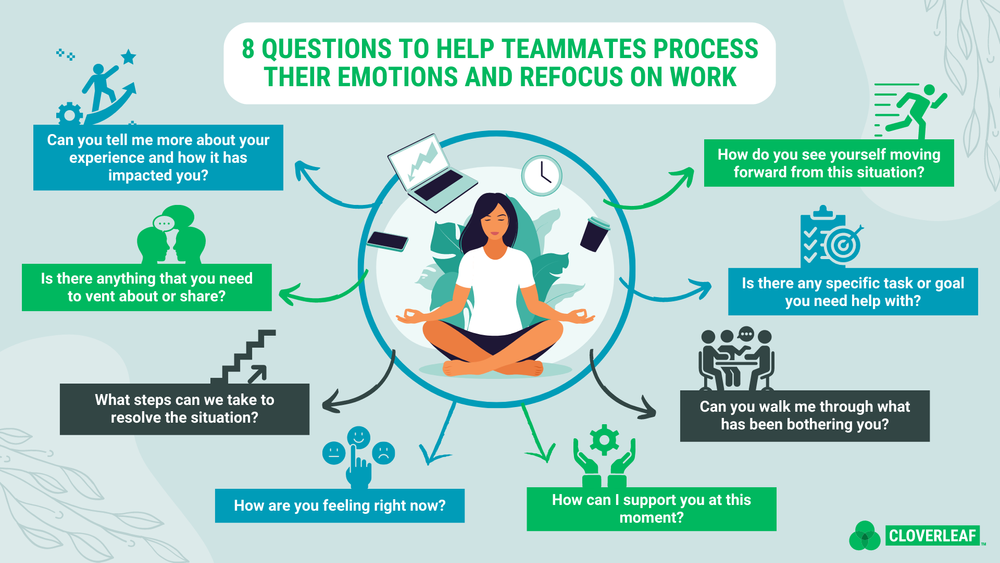
By actively listening to team members verbalize their feelings, you can help them become more aware of their own emotions to help them feel more centered and able to move forward. This small act of empathy can go a long way in creating a positive work environment and improving overall workplace relationships.
How To Increase Emotional Intelligence Among Teammates
The best way to increase emotional intelligence in the workplace is to help improve self-awareness within each team member. Self-awareness enables individuals to identify areas for improvement, manage their emotions, and make more mindful decisions, which is foundational to increasing emotional intelligence.
Teams can proactively support EQ-based initiatives by implementing strategic efforts to help members feel, recognize, regulate, and communicate their emotions.
Utilize Automated Coaching™: Cloverleaf provides personalized, ongoing coaching tips to help employees develop self-awareness and powerful insight about teammates.
Celebrate Feedback And Reviews: Encourage employees to give and receive feedback in a safe by creating the structure to do so with performance management platforms.
Empower Learning and Development: Offer training programs that hone in on emotional intelligence, self-awareness, and personal growth.
Cultivate Open Communication: Work with your team leaders to establish consistent 1-on-1 meetings with direct reports to establish clear initiatives, trust, collaboration, and relationships.
Leaders play a pivotal role in shaping the culture and dynamics of the workplace. That’s why leaders must make emotional intelligence a priority. If not, the rest of the organization may not value developing their EQ or fully supporting initiatives.
And that’s where things can start to unravel. Even further, teams may lose their best talent as many seek places of employment that recognize the importance of emotional intelligence in the workplace.
Talent turnover is an expensive problem and, therefore, must be solved. Thankfully, it’s a problem that can be solved. For the most part, employees leave for reasons that are within the control of employers:
Culture
Work Environment
Growth Opportunities
Leadership Disconnect

By prioritizing emotional intelligence and creating an environment where employees feel valued and challenged, organizations can retain top talent and even attract it.
Conclusion
The next time you encounter an emotionally charged situation, consider using a simple checklist to guide your response. Ask yourself, “How am I feeling?” and “What can I do about it?”
Encourage others to share their emotions by asking, “How are you feeling today?” and “How do you want to show up for this?”
Starting a meeting with these questions can help team members process their emotions and be more present in the moment. Consider offering support by actively listening, responding, or taking action when addressing a situation. This approach can help increase emotional intelligence and create a more supportive and effective work environment.
If you’re looking for additional ways to enhance emotional intelligence in the workplace, visit the post that details an Employee Engagement Strategy For A Human-Centered Workplace.
When you receive disappointing feedback, does it feel like a personal attack or an opportunity to grow?
Carol Dweck has spent decades researching fixed mindset vs growth mindset. In a fixed mindset, we view our abilities as innate, (aka, “just the way I am,”), making failure and constructive feedback feel personal and insurmountable. On the flip side, in a growth mindset, we are comfortable with improving over time, not fearing being wrong, and making failure or difficult feedback an opportunity to be curious about how to do better next time.
The good news is, we can learn to choose a growth mindset. So the next time you get a Cloverleaf coaching tip about an area for growth, know that that is truly what it is: an area for growth.
Or, the next time you realize you made a mistake or didn’t perform up to your own standards, take it as an opportunity. Ask others for feedback, or dig into your Cloverleaf profile to learn more about how you can do your best work.
What about your Teammates?
Just as we can have a growth or fixed mindset about ourselves, we can view others through the same lens.
When a teammate makes a mistake or doesn’t meet your expectations, do you start to question their abilities, or even their character? Or do you feel the freedom to have an open conversation, knowing that your teammate is innately valuable, and can grow from this experience?
The next time a teammate drops the ball, watch your internal reaction. If you find yourself questioning their abilities, head to that teammate’s profile and look through their work style insights to see where their strengths truly are. You may be surprised.
We’re all in this together!

